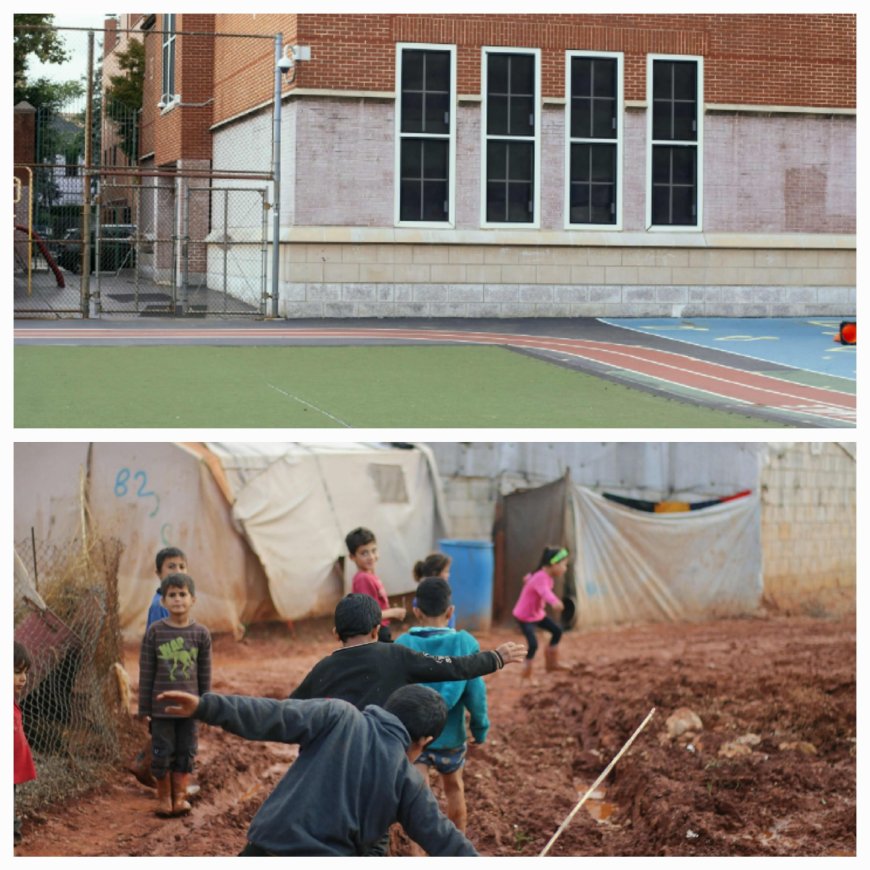THE IMPACT OF SOCIOECONOMIC STATUS ON EDUCATIONAL OPPORTUNITIES
Socioeconomic status (SES) has a profound impact on educational opportunities, with disparities in resources, quality of schooling, and cultural capital perpetuating inequality. Addressing these disparities is crucial to creating a more equitable society. This article dwells on understanding the impact of socioeconomic status on education: How SES affects educational opportunities and outcomes and why addressing disparities is crucial for a more equitable society

Education, the cornerstone of societal progress, is inextricably linked to socioeconomic status, with disparities in resources, quality of schooling, and cultural capital shaping the educational trajectories of individuals. The uneven distribution of educational opportunities across socioeconomic lines is a pervasive issue that perpetuates inequality, limiting the potential of many and hindering the overall development of nations. From early childhood to higher education, socioeconomic status exerts a profound influence on a person's access to quality education, shaping their future prospects and contributing to the widening gap between the haves and the have-nots.
The American Psychological Association, Socioeconomic status (SES) encompasses not only income but also educational attainment, occupational prestige, and subjective perceptions of social status and social class. SES reflects quality-of-life attributes and opportunities afforded to people within society and is a consistent predictor of a vast array of psychological outcomes. Socio-Economic Status (SES) is a measure of family’s economic and social position in relation to others, based on various variables responsible for social and economic development (Gaur, 2013). Socio-economic status is utilized in sociological research and measuring socio-economic status is important tool in descriptive analysis. Moreover, Socioeconomic status has been one of the most strong and consistent variables in explicating variations among social groups (Bateman, 2014) and is defined as an indicator of households‟ combined economic and social welfare variables. Generally, socioeconomic status is viewed as a latent construct and is measured using a composite index of education, health, poverty, income and consumption (Baker, 2014).
According to the Centre for Disease Control and Prevention (2023), the socioeconomic status of a family consists of three main components; education, income, and employment status (occupation). Education plays an important role in health through its influence on multiple socioeconomic factors, such as employment, income, and other economic opportunities. Individuals with lower levels of educational attainment are more likely to lack sociopolitical power and economic resources, leading to adverse occupational, residential, and recreational conditions associated with negative health consequences. These adverse conditions lead to differential exposures to stressors (e.g., unemployment, crime, violence) and fewer resources (e.g., recreation, physical activities) to cope with the accumulation of stressors that contribute to a greater risk of hypertension. Javeria Munir in her research titled “the impact of Socioeconomic status on Academic Achievement” stated a very mind-grasping introductory statement. It goes thus:
“Education is widely recognized as a critical factor influencing an individual's social and economic success, as it provides a pathway to improved opportunities and a better quality of life. Academic achievement, measured by factors such as test scores, grade point averages, and educational attainment, is often considered a crucial indicator of educational success. However, numerous studies have consistently demonstrated that socio-economic status (SES) plays a significant role in shaping academic achievement outcomes (Javeria 2023).”
SES is a multifaceted construct that reflects both material and social advantages or disadvantages (Duncan & Magnuson, 2012). It is well-established in research that individuals from higher socio-economic backgrounds tend to have better access to educational resources, including quality schools, tutoring, books, and technology, which can contribute to enhanced academic performance (Reardon, 2011; Sirin, 2005; Duncan & Magnuson, 2012). Research has shown over and over again that there is a strong link between Socio-economic standing and academic success. Several studies (Sirin, 2005; Reardon, 2011; OECD, 2019) have found that students from higher SES backgrounds tend to do better than their friends from lower SES backgrounds in terms of test scores, grades, and education. Different countries and educational systems have seen these differences in how well people do in school based on their Socio-economic standing. Different things can cause a person's Socioeconomic position to affect how well they do in school.
Income is related to socio-economic status through structural factors. Income is normally defined as pre-tax wages from one’s occupation. This can be measured at the individual level but it is more commonly measured at the household or family level, which consists of the combined income of all household or family members, respectively (Galobardes et al., 2006). It may also be measured in relation to the level of poverty (Lynch and Kaplan 2000). Economists suggested two more variables, i.e., expenditure and debt as a measure of family’s socio-economic status (Gaur, 2013). Study by Onwujekwe et.al (2006) used consumption expenditure as the measure of socio-economic status. Other studies also associated consumption expenditure with socio-economic status of households (Fiorito, 2010) and the socioeconomic status was explained by consumption expenditure at household level (Kamakura &Mazzon, 2013). The household indebtedness is also affected by the socioeconomic status (Kyriopoulos, 2016) and should be additionally considered when assessing health effects of socio-economic status (Munster et. al, 2009).
Households with incomes below the federal poverty level (annual income thresholds set by the federal government to determine financial eligibility criteria have high levels of illness and premature mortality. Individuals with lower incomes lack economic resources, resulting in social disadvantage, poor education, poor working conditions, housing insecurity, and residence in unsafe neighbourhoods. These negative environmental and psychosocial factors affect behavioural and physiological pathways that have proximal effects on health, including increased morbidity and mortality. Workers or employed households are household heads who are currently working for wages, salaries, tips, or commissions. Self-employed households or small business owners are working in a family business. Non-working households are the once who are not currently working (Meh et al., 2009).
The socioeconomic status of a family influences some key areas in the lives of children. For instance, children from higher socio-economic backgrounds often have greater access to quality education and better employment opportunities, leading to higher earning potential and career advancement. Socio-economic status is strongly correlated with health outcomes. Higher SES children tend to have better access to healthcare, healthier lifestyles, and lower levels of stress, leading to better overall health (Adler & Rehkopf, 2008; Galobardes et al., 2006). Socioeconomic disparities in educational opportunities and resources can lead to a less productive workforce and hinder economic growth and innovation.
Socioeconomic inequalities can have a negative impact on the ability of children in underserved communities to learn, hence widening the gap between advantaged and disadvantaged groups over time. Good quality and equitable education is key to the inclusive, peaceful, and sustained development of a society and a country. In Nigeria today, socioeconomic factors, such as income level, parental education, and access to resources, can create barriers that hinder educational opportunities for students in these communities. Furthermore, socioeconomic factors can contribute to disparities in access to technology and internet connectivity, which are increasingly important for modern education. Without access to these resources, students may be at a disadvantage in terms of research, online learning, and developing digital literacy skills.
The relationship between SES and parental involvement is supported by previous studies. Research consistently indicates that parents of higher SES typically allocate more time to engaging in enriching parent–child activities and demonstrate greater cognitive involvement in their children’s learning. In contrast, parents of lower SES are often less able to be involved in their children’s education due to a lack of essential resources such as time and money (Vinopal and Gershenson, 2017, Williams and Sánchez, 2013) or perceiving themselves as incompetent due to limited education knowledge (Li et al., 2020). A large body of literature has documented that parental involvement is beneficial for academic achievement because it fosters a positive and supportive learning environment, and enhances children’s motivation and engagement (Cheung and Pomerantz, 2012, Jeynes, 2005). More important, the mediating role of parental involvement in the relationship between family SES and academic achievement has been supported by empirical studies (e.g., Qiao et al., 2013, Von Otter, 2014).
Previous studies have shown that student engagement might also explain the relationship between SES and children’s academic performance (Schaufeli et al., 2002b, Tomaszewski et al., 2020). Schaufeli, Martinez, et al. (2002) defined student engagement as a positive, fulfilling, and study-related state of mind characterized by vigor, dedication, and absorption. Vigor refers to high levels of energy and mental resilience while working and the willingness and ability to invest effort in one’s work. Dedication refers to a sense of significance, enthusiasm, inspiration, pride, and challenge. Absorption refers to individuals being fully concentrated and happily engrossed in their studies such that time passes quickly and they feel carried away by their studies.
The SES status also affects the teachers as well. While interacting with students, teachers develop expectations for students' academic performance and social skills. The influence of these expectations has been the focus of debate for many decades. Rosenthal and Jacobson were the first to study the effect of expectations on students' academic progress in a low-income elementary school. They concluded that students whose teachers expected a high increase of learning ability within the next year, indeed had higher intelligence scores at the end of the school year. expectations in the classroom.
Lack of access to education presents harmful impacts on the individual and society. First and foremost, not receiving an education can have major consequences on an individual’s voice. It can hinder the development of the skills necessary to represent oneself. This is further evident in the works of The Borgen project (2020) through the continuing oppression of women in developing countries. These women typically marry at a young age and must work at accomplishing domestic chores. In nations such as Saudi Arabia and Nigeria, many women without an educational qualfication struggle to find jobs. Additionally, these women typically cannot read or write and often grow reliant on their husband’s income. In the end, the lack of access robs women of their potential. To add, gender disparity in youth literacy remains prevalent in almost one in five countries.
It is without any denial that in many nations, education often determines employability. These nations rely on well-educated workers to promote their economy and workforce. Employers also use these credentials to differentiate applicants and potential employees. Today, many organizations fighting this issue focus on educating the youth as approximately 71 million 15 to 24-year-olds do not have employment around the world. Without access to education, individuals are more prone to remain at the bottom of the list when it comes to obtaining a job. Even as little as a high school diploma can open up many opportunities for employment.
Many individuals must resort to incredibly dangerous jobs just to make a living if they have limited education. Specifically, women and girls in developing countries often resort to various methods of exploitation to provide for themselves and their families. Education can provide secure work, but without it, people might have a difficult time getting ahead. Exploitation can include sweatshop labor, prostitution and child marriage.
Children often rely on their parents when it comes to their own education; however, it can be quite difficult for a parent to assist their child if they never had access to education. It is important to understand how the lack of education can have consequences on future generations. Uneducated parents face issues such as the inability to help children with their homework or not knowing how to help them find their full potential. According to the American Psychological Association, children of uneducated parents are typically behind their peers when it comes to cognitive development and literacy levels. The effects of this issue were evident in 2014 when approximately 61 million children of primary school age did not attend school.
Researches such as that carried out by the American Psychology Association shows the importance of socioeconomic status in education. For instance, low SES in childhood is related to poor cognitive development, language, memory, socioemotional processing, and consequently poor income and health in adulthood. The school systems in low-SES communities are often underresourced, negatively affecting students’ academic progress and outcomes (Aikens & Barbarin, 2008). Inadequate education and increased dropout rates affect children’s academic achievement, perpetuating the low-SES status of the community. Improving school systems and early intervention programs may help to reduce some of these risk factors; therefore, increased research on the correlation between SES and education is essential. Children from low-SES families are less likely to have experiences that encourage the development of fundamental skills of reading acquisition, such as phonological awareness, vocabulary, and oral language (Buckingham, Wheldall, & Beaman-Wheldall, 2013). Children’s initial reading competency is correlated with the home literacy environment, number of books owned, and parent distress (Aikens & Barbarin, 2008; Bergen, Zuijen, Bishop, & Jong, 2016). However, poor households have less access to learning materials and experiences, including books, computers, stimulating toys, skill-building lessons, or tutors to create a positive literacy environment (Bradley, Corwyn, McAdoo, & García Coll, 2001; Orr, 2003).
Research continues to link lower SES to lower academic achievement and slower rates of academic progress as compared with higher SES communities. Children from low-SES families enter high school with average literacy skills five years behind those of high-income students (Reardon, Valentino, Kalogrides, Shores, & Greenberg, 2013). In 2014, the high school dropout rate among persons 16–24 years old was highest in low-income families (11.6 percent) as compared to high-income families (2.8 percent; National Center for Education Statistics, 2014). The success rate of low-income students in science, technology, engineering, and mathematics disciplines is much lower than that of students who do not come from underrepresented backgrounds (Doerschuk et al., 2016). According to the U.S. Census Bureau (2014), individuals within the top family income quartile are 8 times more likely to obtain a bachelor’s degree by age 24 as compared to individuals from the lowest family income quartile.
In conclusion, socioeconomic status (SES) plays a pivotal role in shaping educational opportunities. Disparities in resources, quality of schooling, and cultural capital perpetuate inequality, limiting the potential of many. To create a more equitable and prosperous society, it is imperative to address these disparities. By advocating for policies that promote equal access to quality education, such as increased funding for schools, early childhood education programs, and parental involvement support, we can ensure that everyone has the opportunity to succeed, regardless of their socioeconomic background.
What's Your Reaction?



































































































